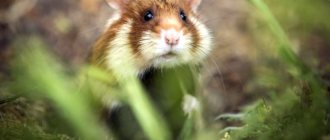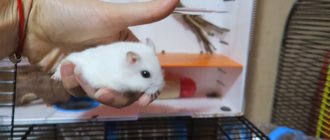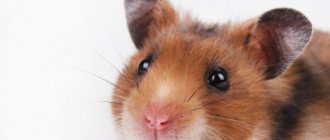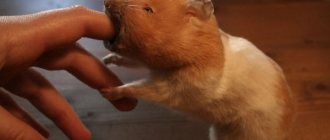A healthy hamster does not make many sounds - it scratches in the bedding and squeaks its wheel. If the pet suddenly starts snorting and squeaking, the owner wonders what to do if the hamster sneezes. Frequent sneezing is by no means the norm for these animals, and such a problem requires treatment .
When an animal sneezes and coughs, this is an attempt by the body to clear the airways. Along with a sharp exhalation, mucus, small particles, and microorganisms fly out. Sneezing and coughing are involuntary reactions based on reflexes. Therefore, a pet cannot “simulate”; it is necessary to look for the cause of the symptoms.
Causes
Allergy
Allergic reactions in rodents are much more often manifested by rhinitis and conjunctivitis, rather than skin problems. New foods in the diet, filler (pine sawdust or colored napkins), a toy. To understand why a hamster sneezes, they analyze what has changed in the habitat. Then they return to the previous situation and observe whether the animal feels better.
Irritation of the mucous membrane
If small particles or caustic aerosols enter the nose, the pet will begin to sneeze. This explains why the hamster snorts after walking around the apartment - he inhaled dust in the corners. Unsuitable sand for swimming - volcanic or with talc in its composition - also irritates the respiratory tract. Hairspray, other aerosols and any strong smell (paint, household chemicals) irritate the sensitive nasal mucosa.
In this case, the sneezing stops with the disappearance of the stimulus, which is not difficult to detect. If a rodent sneezes and squeaks only after sitting in your arms, perfume and other cosmetics may be the cause.
Cold (viral respiratory infection)
When a pet is taken outside, washed, or left in a cage in a draft, sneezing is a consequence of a cold. Hypothermia promotes a viral infection, and the hamster begins to snot. If the animal sneezes and squeaks, but eats well and behaves actively, it is too early to worry. Recovery often occurs within a few days. With rhinitis, the hamster constantly sneezes, but does not cough.
Bronchitis and pneumonia
Pneumonia is a serious disease that can lead to the death of a rodent. Pneumonia is different from the common cold. Signs:
- purulent nasal discharge;
- breathing is difficult: the animal breathes with a whistle, often and with visible effort;
- decreased or absent appetite;
- lethargy, apathy;
- blue tint of mucous membranes.
A peculiarity of rodents is that inflammation of the upper respiratory tract can progress to pneumonia in less than a day.
When a tiny dwarf sneezes and sniffles, a digital x-ray of the lungs will help distinguish pneumonia from a runny nose. An image is needed in case of wheezing and noises during breathing, in order to exclude oncological processes (metastases in the lungs).
The owner needs to be attentive to all strange sounds that the rodent makes. If your pet is "chirping" rather than sneezing or squeaking, it could be a cough. With spastic contractions of the diaphragm, the owner does not understand why the hamster hiccups, while the tiny dwarf is experiencing a coughing fit. Sometimes hamsters can simply hiccup, especially from gluttony. But in this case, their well-being does not worsen.
Other reasons
If a Syrian hamster seems to sneeze and make a squeaking sound as soon as it sees its owner, it may not be a sneeze at all, but a kind of greeting. In this case, the sound is short and cheerful, as if a rubber toy is squeaking.
Why does a hamster squeak?
Understanding the reason for a pet's restless behavior is always difficult, because its squeaking can be associated with a variety of factors. It could be:
- stress;
- lack of drinking water;
- bad dreams;
- disease.
If you recently acquired an animal and the environment is still unusual for it, its squeaking is associated with stress and moving. In this case, the animal becomes afraid of unfamiliar smells and places. It can take 3 weeks or 3 months for the animal to adapt, it all depends on the individual characteristics.
The next reason for a hamster's nervous behavior is lack of water. The pet is trying to attract the attention of its owners and provide itself with vital moisture. In nature, individuals of the hamster family receive water, as a rule, in the morning, when dew appears on the plants.
It is also not uncommon for pets to be noisy in their sleep. This is because hamsters dream, and apparently they aren't always good ones. In this case, the animal emits short intermittent squeaks.
The most serious reason for your pet's squeaking may be illness. The owner needs to take a close look at the behavior of his pet and observe him for some time. If you find that there are any other changes in the behavior of the animal, for example, sneezing has appeared, it is worth familiarizing yourself with the reasons for sneezing in hamsters.
Treatment
First aid
Change of filler and heat. The room temperature is maintained at about 24 C, but the air should not be dry. Lots of white paper towels are placed in the cage: this is both material for a warm nest and a hypoallergenic environment. If an allergy is suspected, corn filler is also recommended.
To increase immunity, add liquid vitamins for rodents and ascorbic acid to the water, and drink an echinacea decoction. They also give dry nettle and coltsfoot.
The eyes and nose are cleaned of secretions with a damp cotton pad to make it easier for the animal to breathe. Sometimes a hamster sniffles a lot due to the fact that the nostrils are clogged with dried secretions.
Local treatment
For ordinary rhinitis, local treatments are prescribed: the antiviral drug Roncoleukin 50,000 units, 1 drop 2 times a day and Tsipromed (drops with antibiotic) in the same dosage. The Syrian hamster is larger than the Djungarian hamster, but it is equally difficult for both of them to put drops into the nose: during the procedure, the animal constantly twitches and spins. You can simply place a drop of the medicine on the nose and wait for your pet to inhale the liquid. Then he snorts himself.
Systemic treatment
If you suspect a serious infection, you should consult a doctor .
But in the absence of a rodent specialist, if a hamster sneezes, every experienced hamster breeder knows what to do at home. Pneumonia is treated with antibiotics. It is not advisable to drink them inside; it can be difficult for an animal with a respiratory infection to swallow. Subcutaneous injections are given with the drug “Baytril 2.5%”. Dose - 0.4 ml (10 mg) per 1 kg of weight. If the hamster weighs 50 g, its dose is 0.02 ml. The drug is administered once a day, in severe cases - 2 times a day, 7-14 days.
Cold
Colds are common among rodents. The causes of the disease are varied. Your pet can become infected from you when you are sick with the flu or ARVI. To prevent this from happening, have as little contact with him as possible, and cover your mouth and nose with a special gauze bandage when feeding. You can easily catch a cold in your pet after bathing if you don’t dry its fur well. But the most common cause of the disease is that the hamster's cage is in a draft. The symptoms of a cold are:
- Frequent sneezing;
- Wet nose;
- Scratching the nose with paws;
- Hard breath;
- Drowsiness, lethargy, or aggression;
- Loss of appetite.
At the first signs of a cold (sneezing, scratching the nose), remove the cage to a place protected from drafts, add more napkins there so that the hamster can use them to hide and warm up. Monitor the temperature in the room, it should not be lower than 25 degrees. You can treat it at home with chamomile tea and vitamins purchased at a veterinary pharmacy to maintain immunity. With mild symptoms, the rodent recovers within a few days. But if your hamster is wheezing and coughing, then contact your veterinarian. Most likely, the disease begins to progress and enters a more complex stage.
Rhinitis
Inflammation of the nasal mucosa due to hypothermia leads to a runny nose in a hamster. And also rhinitis can be allergic. In such cases, its appearance is provoked by dust contained in the bedding or filler.
Signs of rhinitis include:
- Discharge from the nasal passages.
- Sneezing.
- Difficulty breathing.
Since the symptoms of a runny nose closely resemble those of pneumonia, only a veterinarian should make a diagnosis. Natural preparations are used for treatment; in some cases, inhalations will be needed. It is imperative to get rid of the cause of the disease.
Control measures
The fight against sneezing consists of treatment (in the case of bronchopneumonia, as well as rhinitis) and elimination of irritants. Of the treatment methods described by hamster breeders, acceptable ones include cleaning the eyes and muzzle from secretions, as well as placing antimicrobial ophthalmic drops, for example, Tsipromed, on the nose twice a day.
The idea of fortifying drinks is pointless; the active ingredients decompose within two hours. It is much more effective to constantly keep dry fortified treats purchased at the pet store in the cage.
It is doubtful whether you need to heat your hamster; you can overdo it and he will get heatstroke, which is more dangerous than sneezing. But it is necessary to protect the animal from drafts. You can put a piece of paper towel in the cage, it will be more fun for the hamster.
If sneezing is caused by allergic phenomena, the following measures should be taken:
- Stop smoking and using cosmetics.
- Remove ornamental plants.
- Replace toilet filler with hypoallergenic one.
- Instead of economy-class feed, use premium quality food.
To prevent a hamster from sneezing, it is necessary to create a comfortable environment for it, protect it from drafts, not treat it with human food, stop treating it like a toy, not bathe it, and not invent other methods of torment. The animal is sensitive to lack of attention, but tolerates excess much worse.
We invite you to join our group on VKontakte or Odnoklassniki, where new articles for pet owners are published.
Allergic reaction
Its occurrence can be facilitated by the appearance of new or prohibited foods in the diet (sweets, spicy, salty, flour, exotic fruits), the use of other fillers, and toys.
The introduction of new foods must be done gradually, starting with small portions. If behavior and appearance do not change, further feeding can be continued. Allergies can occur not only to natural products, but also to dry food.
Important! This disease is complex. It may not appear immediately, but several days after taking inappropriate food or even after some time. The veterinarian will prescribe treatment and create the correct diet.
The hamster sneezes. Be healthy, baby!
Domestic hamsters do not naturally have strong immunity. Due to the accelerated metabolism, any disease in these animals progresses very quickly. Therefore, you should be careful about your pet's health. to start treatment on time and prevent complications.
There can be many reasons for a hamster sneezing.
Sneezing is a protective reaction of the body aimed at removing mucus, dust and other irritating factors from the upper respiratory tract through a sharp exhalation.
The reasons for this reaction in hamsters can be:
- Hypothermia
- Infectious diseases
- Reaction to any allergens
Often sneezing is accompanied by the squeaking of a domestic rodent and is a symptom of the following diseases:
- SARS
- cold
- rhinitis
- bronchitis
- pneumonia
- allergy.
Allergic reactions in hamsters most often occur to food and household chemicals.
Symptoms
Hamsters are clean, and it is difficult to notice a transparent secretion. Indirect signs indicate a runny nose:
- sneezing and snorting;
- difficulty breathing due to swelling of the nasal passages;
- cyanosis of mucous membranes;
- Frequent scratching of the face with paws.
A clear sign of an infectious disease is redness of the conjunctiva and profuse lacrimation. Later, a purulent sticky exudate forms in the corners of the eyes, sticking the eyelids together. Often a painful stye appears on the eyelash edge.
Going to the veterinarian
If, after all your efforts, it was not possible to discover the cause of the disease, your hamster sneezes and squeaks, he sniffles or wheezes, then a trip to the veterinarian is inevitable. After all, if your pet’s nose is excessively moist, his eyes are constantly watering, his fur has taken on an unkempt appearance, he snorts all the time, and signs of aggression have appeared in his behavior (or, conversely, your pet has become too passive), then it is likely that he has pneumonia. And the help of a specialist is extremely necessary here.
The veterinarian will help you find out the real reason why your hamster is sneezing. And of course, he will give recommendations regarding further care for your pet.
If you want your pet to always have excellent health, make sure it eats properly and provides the necessary care. Create conditions with a temperature that is comfortable for him at 20-22 C and protect him from drafts.
That's all. Now you know what to do if your hamster suddenly starts sneezing.
https://www.youtube.com/watch?v=l3MSpcqHAKY
moy-homyachok.ru
From time to time we receive disturbing letters from hamster lovers
Owners notice that their small pets sneeze often and a lot. The questions for the editors are, in general, clear: how dangerous is this? What is the nature of hamster sneezing? Do I need to do anything?
Respiratory tract infections. Animals, of course, cannot catch a cold or flu from us. But it’s easy to pick up a respiratory tract infection! A sick hamster is immediately visible: runny nose, half-closed eyes, loss of appetite, lethargy, etc. Plus, of course, sneezing! It is advisable to show the hamster to a veterinarian: if nothing is done, pneumonia may develop, which can be fatal. On the contrary, treatment started in a timely manner will immediately bear fruit. Your pet can get the infection from drafts, food and other hamsters.
Allergic reactions. Don't be surprised: allergies in hamsters are not that rare. Many animals react to the fabric softeners you use to wash fleece bedding. But it doesn’t have to be: anything can act as an allergen! And filler, and some of the ingredients of bagged food, and even dust mites.
You've probably figured out what to do next: try a different filler, a different food, try a general overhaul of the cage, etc.
Nothing helps and your hamster continues to sneeze? Then consult a veterinarian who specializes in working with small rodents.
Other irritants. Inspect the cage first. Do you notice any strong odors? Hamsters, by the way, are very sensitive to outside odors! Many animals cannot tolerate the aroma of pine or cedar shavings used as filler. In addition, small particles often become clogged in the respiratory tract, causing the animal to sneeze.
Now look around the room critically. Do you use electric diffusers that distribute essential oils and other scents? Don't light scented candles? Don't use air fresheners and sprays? Hamsters are critical of these “devices.”
Hamsters can react to powders, cleaning products and other household chemicals. Try giving them up and see what happens. If for some reason this is not possible, then choose another location for the cage.
Maybe the reason is something more serious? It's possible! Thus, hamsters often begin to sneeze when tumors develop in the head and especially the nose. The main difficulty is that tumors are difficult to diagnose right away. It will take a lot of effort and money, which not all owners are willing to do. Examine your pet for bloody nasal discharge. If something like this is present, it means it’s time to sound the alarm.
Pay attention to your pet's behavior. He retains mobility, appetite, and is not tormented by thirst - most likely, there is no reason for serious concern
On the contrary, the hamster is lethargic, refuses to eat, prefers to sleep most of the time - show him to the vet as soon as possible. Perhaps, based on the results of the examination, the veterinarian will prescribe a course of antibiotics or antihistamines.
At the end of the article, we emphasize once again: if possible, choose spacious cages for your hamster! Maintain exemplary cleanliness in the cage. Do not place it in drafts! Then there will be an order of magnitude fewer problems with your pet!
Photo: pixabay.com
ilike.pet
How not to treat
The mistake of many breeders is that at the first sign of a cold, they begin to treat their pet on their own, thereby causing irreparable harm to its body, because treatment, in most cases, is carried out according to human canons. Under no circumstances should you give your rodent paracetamol, aspirin, tetracycline, or ampicillin without consulting a veterinarian. These drugs have a detrimental effect on his health, especially if you do not know the dosage and duration of treatment.
The disease is easier to prevent than to treat, so prevent colds for your pet twice a year - autumn and spring. To do this, use homeopathic remedies (consult a veterinarian), chamomile tea, which disinfects the oral cavity well and kills germs. In the spring, when the animal’s body experiences a particular lack of vitamins, it is good to give it vitamin drops purchased at a pet store. It will also be very useful to review the animal’s diet and include more greens, vegetables, and fruits in its diet, only within reasonable limits.










